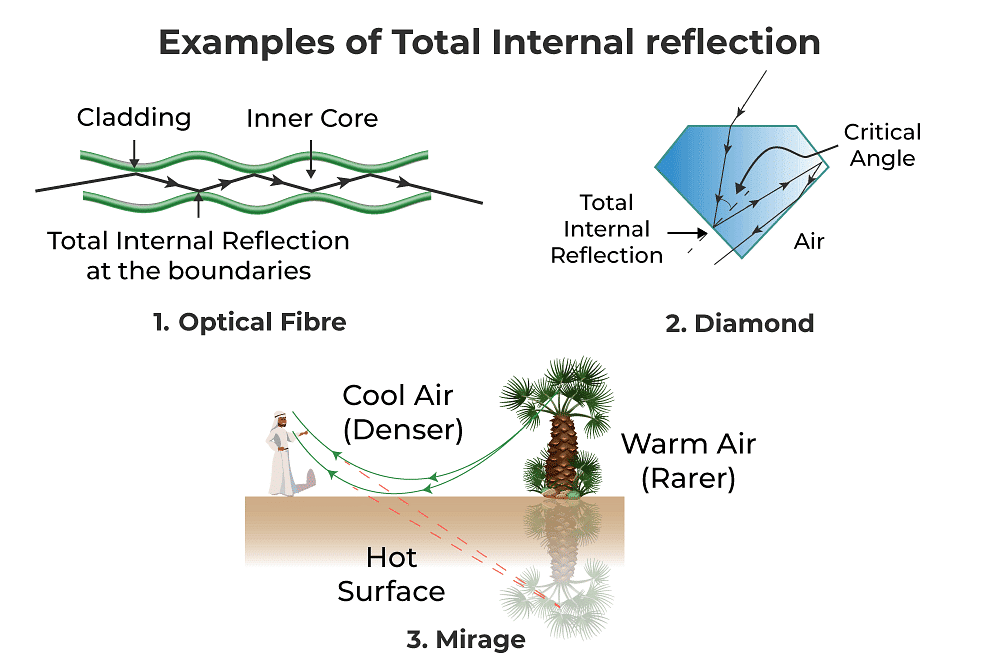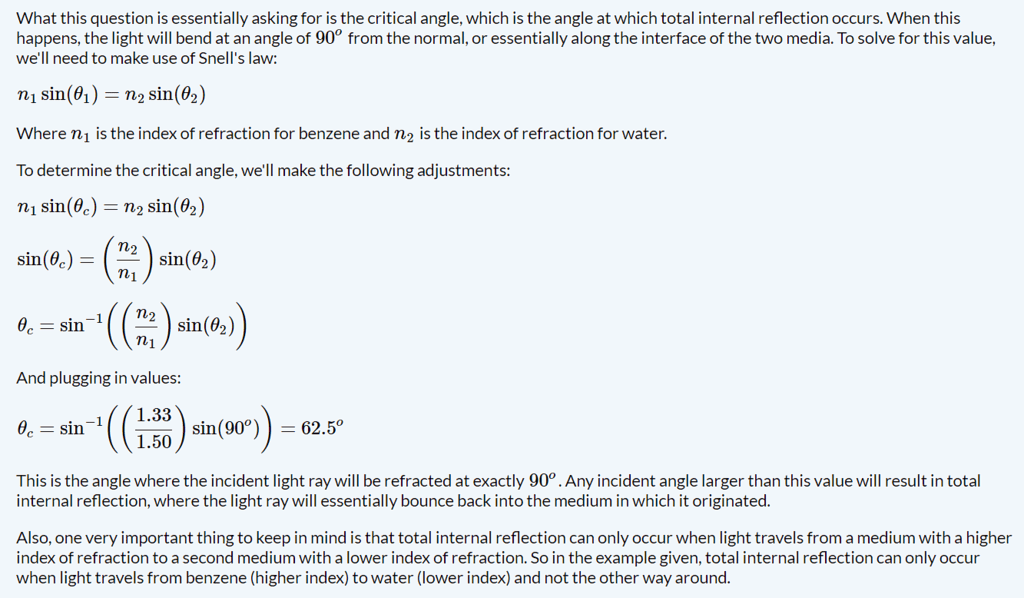Total Internal Reflection | Physics for JEE Main & Advanced PDF Download
| Table of contents |

|
| What is Total Internal Reflection? |

|
| Formula of Total Internal Reflection |

|
| Applications of Total Internal Reflection |

|
| Important Questions for Exam |

|
Have you ever noticed, how beautifully a diamond shines? It seems like light rays are stuck inside the structure of the diamond and getting reflected continuously. This is an application of Total Internal Reflection, which we are going to study about in detail in this document.
What is Total Internal Reflection?
When a light ray travelling from a denser medium towards a rarer medium is incident at the interface at an angle of incidence greater than the critical angle, then light rays get reflected back into the denser medium. This phenomenon is called Total Internal Reflection.
 Total Internal Reflection
Total Internal Reflection
- Consider the following situation. A ray of light passes from a medium of water to that of air. Light rays will be refracted at the junction separating the two media.
- Since it passes from a medium with a higher refractive index to that having a lower refractive index, the refracted light ray bends away from the normal.
- At a specific angle of incidence, the incident ray of light is refracted in such a way that it passes along the surface of the water. This particular angle of incidence is called the critical angle. Here the angle of refraction is 90 degrees.
- When the angle of incidence is greater than the critical angle, the incident ray is reflected back to the medium. We call this phenomenon total internal reflection.
- The refractive index is maximum for the violet colour of light and minimum for the red colour of light. i.e., μv > μ R therefore, the critical angle is maximum for the red colour of light and minimum for the violet colour of light, i.e., Cv < CR
The following are the two conditions of total internal reflection:
- The light ray moves from a more dense medium to a less dense medium.
- The angle of incidence must be greater than the critical angle.
Note: The critical angle increases with temperature.
Formula of Total Internal Reflection
Total Internal Reflection: 
Critical Angle, θ: sinθ = n2/n1 (n1 > n2)
- r is the angle of refraction
- i is the angle of incidence
- n1 is the refractive index in medium 1
- n2 is the refractive index in medium 2
- θ is the critical angle
Applications of Total Internal Reflection
 Applications of Total Internal Reflection
Applications of Total Internal Reflection
➢ Optical Fibre
- When the incident ray falls on the cladding, it suffers total internal reflection as the angle formed by the ray is greater than the critical angle.
- Optical fibres have revolutionised the speed with which signals are transferred, not only across cities but across countries and continents making telecommunication one of the fastest modes of information transfer.
- Optical fibres are also used in endoscopy.
➢ Diamond
- When the incident ray falls on every face of the diamond such that the angle formed, the ray is greater than the critical angle. The critical value of the diamond is 23°.
- This condition is responsible for the total internal reflection in a diamond which makes it shine.
➢ Mirage
- It is an optical illusion that is responsible for the appearance of the water layer at short distances in a desert or on the road.
- Mirage is an example of total internal reflection which occurs due to atmospheric refraction.
Important Questions for Exam
Example.1: An optical fibre made up of glass with a refractive index of n1 = 1.5 which is surrounded by another glass with refractive index n2. Find the refractive index n2 of the cladding such that the critical angle between the two cladding is 80°.
Solution.
Critical angle, θ = 80°
Refractive index, n1 = 1.5
Refractive index n2 =?
Using the below formula, we can calculate n2:
sinθ = n2/n1
sin80∘ = (n2 / 1.5)
n2 = 1.5 * sin80∘
n2 = 1.48
Example.2: Find the refractive index of the medium whose critical angle is 40°.
Solution.
Critical angle, θ = 40°
The refractive index of the medium, μ =?
μ = 1/sinθ
μ = 1/sin40∘
μ =1/0.65
µ = 1.6
Example.3: Which of the following is an example of total internal reflection?
1. Mirror
2. Twinkling of stars
3. Mirage
4. Thin film of soap bubble
Answer: Option 3: Mirage
Explanation: Mirage is an example of total internal reflection.On hot summer days, the air near the ground becomes hotter than the air at higher levels. Due to this, there is a difference in the refractive index of the air in different layers.
- To a distant observer, the light appears to be coming from somewhere below the ground. The observer naturally assumes that light is being reflected from the ground, say, by a pool of water near the tall object.
- Such inverted images of distant tall objects cause an optical illusion to the observer. This phenomenon is called a mirage.
Example.4: A scuba diver is wearing a head lamp and looking up at the surface of the water. If the minimum angle to the vertical resulting in total internal reflection is 25∘, what is the index of refraction of the water?
θair=1
a) 2.37
b) 0.85
c) 0.49
d) 1.12
Answer: 2.37
Solution: 
Example 5: A ray of light makes a transition from a sample of benzene to water. What is the minimum angle the light must make with respect the normal in order for the light to be completely reflected back into the sample of benzene? The index of refraction for water is 1.33 and for benzene is 1.50.
Solution:

|
320 videos|999 docs|210 tests
|
FAQs on Total Internal Reflection - Physics for JEE Main & Advanced
| 1. What is Total Internal Reflection? |  |
| 2. What is the formula for Total Internal Reflection? |  |
| 3. What are the applications of Total Internal Reflection? |  |
| 4. What are some important questions related to Total Internal Reflection? |  |
| 5. How is Total Internal Reflection relevant to the NEET exam? |  |





















